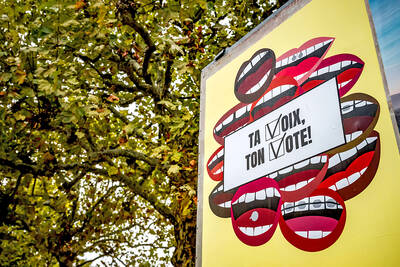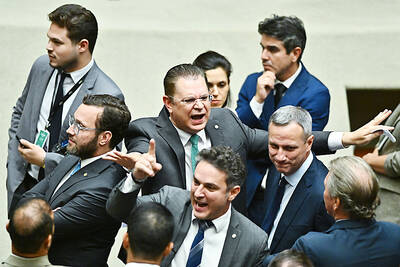Togo’s election commission declared the son of the country’s late dictator winner of the presidential race, extending the family’s rule into a fifth decade in a blow to Togo’s opposition, which vowed to take to the streets.
Provisional results on Saturday showed that Togolese President Faure Gnassingbe won 1.2 million votes, representing 60.9 percent of the roughly 2 million votes cast in the country, said Issifou Tabiou, the head of the election body.
Opposition leader Jean-Pierre Fabre, who had earlier accused the ruling party of rigging the election, received 692,584 votes, or 33.9 percent.
As it became clear that the opposition had lost and Gnassingbe would get a second term, Fabre led a group of about 200 protesters to a downtown square where they were pushed back by anti-riot police who fired tear gas, witnesses and a police spokesman said.
The election was only the second since the death of Eyadema Gnassingbe, who grabbed power in a 1967 coup, only for his son to seize power upon the dictator’s death in 2005. The younger Gnassinge went on to win elections that same year that were widely viewed as rigged.
Pro-Gnassingbe soldiers openly intimidated voters at polling stations and in several instances opened fire with live ammunition before stealing the ballot box, Amnesty International said.
Although the opposition has claimed that this election was rigged, international observers said earlier they have not seen overt evidence of fraud. But they say there is evidence that the ruling party tried to buy off voters.
During campaign rallies, opposition supporters chanted “We were not paid to be here” — a jab at Gnassingbe who they accuse of handing out cash and bags of rice to supporters.
Election monitors from the EU’s observation mission were present in at least four regions of the country when members of the ruling party handed out rice at a cost three to four times less than at the market, the mission’s preliminary report said on Saturday.
The district by district results indicated that turnout was between 70 percent and 80 percent in the north of the country, where Eyadema Gnassingbe was born and which has traditionally voted for the ruling party. By contrast, voter turnout was woefully low in the south and in the capital, the opposition’s stronghold.
Jean-Claude Homawoo, the vice president of the election commission, said voters were so used to elections being rigged that they gave up hope just when their vote may have counted.
“It’s the effect of successive failure. So many times we went and voted in elections we knew we had won, only for the opposite result to be declared. So people have become tired. They don’t believe their vote counts anymore,” he said.

A plan by Switzerland’s right-wing People’s Party to cap the population at 10 million has the backing of almost half the country, according to a poll before an expected vote next year. The party, which has long campaigned against immigration, argues that too-fast population growth is overwhelming housing, transport and public services. The level of support comes despite the government urging voters to reject it, warning that strict curbs would damage the economy and prosperity, as Swiss companies depend on foreign workers. The poll by newspaper group Tamedia/20 Minuten and released yesterday showed that 48 percent of the population plan to vote

PARLIAMENT CHAOS: Police forcibly removed Brazilian Deputy Glauber Braga after he called the legislation part of a ‘coup offensive’ and occupied the speaker’s chair Brazil’s lower house of Congress early yesterday approved a bill that could slash former Brazilian president Jair Bolsonaro’s prison sentence for plotting a coup, after efforts by a lawmaker to disrupt the proceedings sparked chaos in parliament. Bolsonaro has been serving a 27-year term since last month after his conviction for a scheme to stop Brazilian President Luiz Inacio Lula da Silva from taking office after the 2022 election. Lawmakers had been discussing a bill that would significantly reduce sentences for several crimes, including attempting a coup d’etat — opening up the prospect that Bolsonaro, 70, could have his sentence cut to

A powerful magnitude 7.6 earthquake shook Japan’s northeast region late on Monday, prompting tsunami warnings and orders for residents to evacuate. A tsunami as high as three metres (10 feet) could hit Japan’s northeastern coast after an earthquake with an estimated magnitude of 7.6 occurred offshore at 11:15 p.m. (1415 GMT), the Japan Meteorological Agency (JMA) said. Tsunami warnings were issued for the prefectures of Hokkaido, Aomori and Iwate, and a tsunami of 40cm had been observed at Aomori’s Mutsu Ogawara and Hokkaido’s Urakawa ports before midnight, JMA said. The epicentre of the quake was 80 km (50 miles) off the coast of

RELAXED: After talks on Ukraine and trade, the French president met with students while his wife visited pandas, after the pair parted ways with their Chinese counterparts French President Emmanuel Macron concluded his fourth state visit to China yesterday in Chengdu, striking a more relaxed note after tough discussions on Ukraine and trade with Chinese President Xi Jinping (習近平) a day earlier. Far from the imposing Great Hall of the People in Beijing where the two leaders held talks, Xi and China’s first lady, Peng Liyuan (彭麗媛), showed Macron and his wife Brigitte around the centuries-old Dujiangyan Dam, a World Heritage Site set against the mountainous landscape of Sichuan Province. Macron was told through an interpreter about the ancient irrigation system, which dates back to the third century